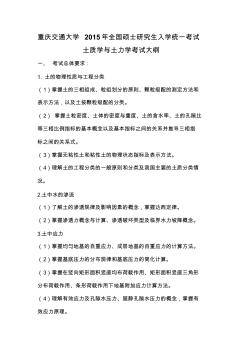土力学2015年
土力学2015年基本信息
| 书 名 | 土力学 | 作 者 | 苏栋 |
|---|---|---|---|
| 出版社 | 清华大学出版社 | 出版时间 | 2015年08月01日 |
| 定 价 | 49 元 | ISBN | 9787302403531 |
| 印 次 | 1-1 | 印刷日期 | 2015.08.20 |
绪论(Introduction)
第1章土的物理性质及分类(PhysicalPropertiesofSoil
andSoilClassification)
1.1概述(Introduction)
1.2土的形成(SoilFormation)
1.2.1风化作用(Weathering)
1.2.2搬运与沉积(TransportationandSedimentation)
1.3土的组成(CompositionofSoil)
1.3.1固体颗粒(SolidParticle)
1.3.2土中水(WaterinSoil)
1.3.3土中气(AirinSoil)
1.4土的结构与构造(SoilFabricandSoilStructure)
1.4.1土的结构(SoilFabric)
1.4.2土的构造(SoilStructure)
1.5土的物理性质指标(PhysicalPropertyIndexesofSoil)
1.5.1基本指标(BasicIndexes)
1.5.2换算指标(ConvertedIndexes)
1.5.3指标之间的换算(RelationshipsbetweenIndexes)
1.6土的物理状态指标(PhysicalStateIndexesofSoil)
1.6.1无黏性土的相对密度(RelativeDensityofCohesionlessSoil)
1.6.2黏性土的界限含水量及状态指标(BoundaryWaterContentsand
StateIndexesofCohesiveSoil)
1.7土的分类(SoilClassification)
1.7.1土的分类原则(PrinciplesofSoilClassification)
1.7.2《土的工程分类标准》的分类(ClassificationofStandardfor
EngineeringClassificationofSoil)
1.7.3《建筑地基基础设计规范》的分类(ClassificationofCodefor
DesignofBuildingFoundation)
1.8土的压实(SoilCompaction)
1.8.1黏性土的压实(CompactionofCohesiveSoil)
1.8.2无黏性土的压实(CompactionofCohesionlessSoil)
思考题(ThinkingQuestions)
习题(Exercises)
第2章土中应力(StressesinSoil)
2.1概述(Introduction)
2.2应力、应变和土的弹性变形(Stresses,StrainsandElastic
DeformationofSoil)
2.2.1应力(Stresses)
2.2.2应变(Strains)
2.2.3胡克定律(HookesLaw)
2.3有效应力原理(ThePrincipleofEffectiveStress)
2.4土的自重应力(StressesDuetoSelfWeightofSoil)
2.4.1竖向自重应力(VerticalStressDuetoSelfWeightofSoil)
2.4.2水平自重应力(HorizontalStressDuetoSelfWeightofSoil)
2.5基底压力(ContactPressureunderFoundations)
2.5.1柔性基础与刚性基础的基底压力分布(ContactPressureDistribution
underFlexibleFoundationsandRigidFoundations)
2.5.2基底压力的简化计算(SimplifiedCalculationof
ContactPressure)
2.5.3基底附加压力(AdditionalPressureunderFoundations)
2.6地基附加应力(AdditionalStressesinSoil)
2.6.1集中力作用下的地基附加应力(AdditionalStresses
inSoilDuetoaPointLoad)
2.6.2分布荷载作用下的地基附加应力(AdditionalStressesin
SoilDuetoDistributedLoads)
2.6.3平面应变问题的地基附加应力(AdditionalStressesin
SoilunderPlainStrainCondition)
思考题(ThinkingQuestions)
习题(Exercises)
第3章土的渗透性与渗流(PermeabilityandFlowof
WaterthroughSoil)
3.1概述(Introduction)
3.2土的渗透规律(LawforFlowofWaterthroughSoil)
3.2.1水头与水力梯度(HeadandHydraulicGradient)
3.2.2达西渗透定律(DarcysLaw)
3.2.3渗透系数的测定(DeterminationoftheCoefficient
ofPermeability)
3.2.4影响渗透系数的因素(FactorsAffectingtheCoefficientof
Permeability)
3.2.5层状地基的等效渗透系数(TheEquivalentPermeabilityof
StratifiedSoil)
3.3渗透力及渗透破坏(SeepageForceandSeepageFailure)
3.3.1渗透力(SeepageForce)
3.3.2渗透破坏(SeepageFailure)
3.4二维渗流与流网(TwoDimensionalFlowandFlowNets)
3.4.1二维稳定渗流场的拉普拉斯方程(LaplacesEquationfor
TwoDimensionalSteadyFlow)
3.4.2流网及其应用(FlowNetsandTheirApplication)
3.4.3各向异性土体的流网(FlowNetsforAnisotropicSoil)
思考题(ThinkingQuestions)
习题(Exercises)
第4章土的一维压缩与固结(OneDimensionalCompressionand
ConsolidationofSoil)
4.1概述(Introduction)
4.2土的一维压缩特性及压缩性指标(CharacteristicsofOneDimensional
CompressibilityofSoilandCompressibilityParameters)
4.2.1侧限压缩试验(LaterallyConfinedCompressionTest)
4.2.2压缩性指标(CompressibilityParameters)
4.2.3应力历史对土的压缩性的影响(EffectsofStressHistory
onSoilCompressibility)
4.3地基沉降量的计算(SettlementCalculation)
4.3.1均质薄土层的一维压缩计算(CalculationofOneDimensional
CompressionofaUniformThinLayerofSoil)
4.3.2地基沉降量计算的分层总和法(SplittingSummationMethod
forSettlementCalculation)
4.4饱和土的渗流固结(SeepageConsolidationofSaturatedSoil)
4.4.1饱和土的渗流固结模型(SeepageConsolidationModelof
SaturatedSoil)
4.4.2太沙基一维渗流固结理论(OneDimensionalSeepage
ConsolidationTheoryofTerzaghi)
4.5固结系数的确定方法(DeterminationoftheCoefficient
ofConsolidation)
4.5.1时间平方根法(TheRootTimeMethod)
4.5.2时间对数法(TheLogTimeMethod)
4.6黏土的次固结沉降(SecondaryConsolidationofClay)
思考题(ThinkingQuestions)
习题(Exercises)
第5章土的剪切性状和抗剪强度(ShearBehaviorandShearStrength
ofSoil)
5.1概述(Introduction)
5.2排水条件下土的典型剪切性状(TypicalShearBehaviorofSoil
underDrainedCondition)
5.2.1剪应力作用下土的典型性状(TypicalBehaviorofSoilto
ShearingStress)
5.2.2法向有效应力对土的剪切性状的影响(EffectofNormal
EffectiveStressonShearBehaviorofSoil)
5.3土的抗剪强度理论(TheoryofShearStrengthofSoil)
5.3.1库仑公式及抗剪强度指标(CoulombsLawandShear
StrengthParameters)
5.3.2莫尔库仑强度理论(MohrCoulombStrengthTheory)
5.3.3土的极限平衡状态(LimitEquilibriumStateofSoil)
5.4土的剪切试验(ShearTestsofSoil)
5.4.1直接剪切试验(DirectShearTest)
5.4.2常规三轴试验(ConventionalTriaxialTest)
5.4.3无侧限抗压强度试验(UnconfinedCompressionTest)
5.4.4十字板剪切试验(VaneShearTest)
5.4.5其他试验方法(OtherTestMethods)
5.5常规三轴试验中土的等向压缩性状和剪切性状(IsotropicCompression
andShearBehaviorofSoilinConventionalTriaxialTests)
5.5.1三轴应力条件下的孔隙压力系数(PorePressureCoefficients
undertheTriaxialStressCondition)
5.5.2常规三轴压缩试验的应力路径(StressPathsinConventional
TriaxialCompressionTests)
5.5.3常规三轴试验中土的等向压缩性状(IsotropicCompression
BehaviorofSoilinConventionalTriaxialTests)
5.5.4常规三轴压缩试验中砂土的剪切性状(ShearBehaviorofSandin
ConventionalTriaxialCompressionTests)
5.5.5常规三轴压缩试验中黏土的剪切性状(ShearBehaviorofClayin
ConventionalTriaxialCompressionTests)
思考题(ThinkingQuestions)
习题(Exercises)
第6章土的临界状态和本构模型(ConceptoftheCriticalState
andConstitutiveModelsofSoil)
6.1概述(Introduction)
6.2土的临界状态(ConceptoftheCriticalStateofSoil)
6.2.1临界状态的定义(DefinitionoftheCriticalState)
6.2.2基于临界状态的黏土行为预测(PredictionofClayBehavior
BasedontheConceptoftheCriticalState)
6.3弹塑性模型及塑性理论基础(ElastoPlasticModelsand
BasicConceptsofPlasticTheory)
6.3.1弹塑性模型(ElastoPlasticModels)
6.3.2塑性理论基础(BasicConceptsofPlasticTheory)
6.4剑桥黏土模型(CamClayModels)
6.4.1原始剑桥黏土模型(TheOriginalCamClayModel)
6.4.2修正剑桥黏土模型(TheModifiedCamClayModel)
6.5与状态相关的剪胀性砂土模型(ASandModelwith
StateDependentDilatancy)
6.5.1与状态相关的剪胀性(StateDependentDilatancy)
6.5.2三轴应力空间简化砂土模型(ASimplifiedSandModel
intheTriaxialStressSpace)
思考题(ThinkingQuestions)
习题(Exercises)
第7章土压力理论(EarthPressureTheories)
7.1概述(Introduction)
7.2挡土结构及土压力(RetainingStructuresandEarthPressures)
7.2.1挡土结构的类型(TypesofRetainingStructure)
7.2.2土压力类型(TypesofEarthPressure)
7.2.3土压力理论(EarthPressureTheories)
7.3静止土压力的计算(CalculationoftheEarthPressureatRest)
7.4朗肯土压力理论(RankinesEarthPressureTheory)
7.4.1朗肯主动土压力(RankinesActiveEarthPressure)
7.4.2朗肯被动土压力(RankinesPassiveEarthPressure)
7.5库仑土压力理论(CoulombsEarthPressureTheory)
7.5.1库仑主动土压力(CoulombsActiveEarthPressure)
7.5.2库仑被动土压力(CoulombsPassiveEarthPressure)
7.5.3黏性土的库仑土压力(CoulombsEarthPressure
forCohesiveSoil)
7.6朗肯与库仑土压力理论的比较(ComparisonbetweenRankinesand
CoulombsEarthPressureTheories)
7.7几种常见情况下的土压力计算(EarthPressureCalculation
inSeveralCommonSituations)
7.7.1作用均布荷载时(EffectofUniformlyDistributedLoads)
7.7.2墙后土体分层(EffectofLayeredBackfills)
7.7.3有地下水作用(EffectofGroundWater)
思考题(ThinkingQuestions)
习题(Exercises)
第8章土坡稳定分析(StabilityAnalysisofSoilSlopes)
8.1概述(Introduction)
8.2无黏性土坡稳定分析(StabilityAnalysisofCohesionlessSlopes)
8.2.1无渗流作用时的无黏性土坡(CohesionlessSoilSlopes
withoutSeepage)
8.2.2有渗流作用时的无黏性土坡(CohesionlessSoilSlopesunder
SeepageCondition)
8.3黏性土坡稳定分析(StabilityAnalysisofCohesiveSlopes)
8.3.1整体圆弧滑动法(TheCircularSlipSurfaceMethod)
8.3.2条分法(TheSlicesMethod)
8.4黏性土土坡稳定分析的其他方法(OtherMethodsforStability
AnalysisofCohesiveSlopes)
8.4.1稳定数法(TheStabilityNumberMethod)
8.4.2不平衡推力法(TheImbalanceThrustForceMethod)
思考题(ThinkingQuestions)
习题(Exercises)
第9章地基承载力(BearingCapacityofFoundationSoil)
9.1概述(Introduction)
9.2地基破坏模式(FailureModesofFoundationSoil)
9.2.1整体剪切破坏(GeneralShearFailure)
9.2.2局部剪切破坏(LocalShearFailure)
9.2.3冲切破坏(PunchingShearFailure)
9.3地基临塑荷载和临界荷载(TheCriticalEdgePressureandthe
CriticalPressureofFoundationSoil)
9.3.1塑性区边界方程的推导(DerivationoftheBoundaryEquationofPlasticZone)
9.3.2临塑荷载及临界荷载(TheCriticalEdgePressureand
theCriticalPressure)
9.4地基极限承载力(TheUltimateBearingCapacityofFoundationSoil)
9.4.1普朗德尔瑞斯纳公式(PrandtlReissnersEquation)
9.4.2太沙基公式(TerzaghisEquation)
9.4.3汉森公式(HansensEquation)
9.4.4地基承载力的安全度(FactorofSafetyforBearingCapacity
ofFoundationSoil)
思考题(ThinkingQuestions)
习题(Exercises)
附录A常用术语符号表(Notations)
附录B习题参考答案(ReferenceAnswers)
参考文献(References) 2100433B
土力学2015年造价信息
本书立足于经典土力学的内容,并吸收部分现代土力学的发展成果,系统地介绍了土的基本行为特性、土力学的基本原理和分析计算方法。
全书共分9章,主要内容包括土的物理性质及分类、土中应力、土的渗透性与渗流、土的一维压缩与固结、土的剪切性状和抗剪强度、土的临界状态和本构模型、土压力理论、土坡稳定分析和地基承载力等,每章后均附有思考题和习题,附录提供习题参考答案,并为任课教师免费提供电子课件。
本书主要作为高等学校土木工程、水利工程等有关专业本科学生的土力学课程教材,也可作为研究生教学参考书,还可供有关工程技术人员参考。
土力学2015年常见问题
-
一本供土木工程专业开设的“土力学与基础工程”课程或“土力学”和“基础工程”课程用的教科书。《土力学与基础工程》系统阐述了土的性质及工程分类、地基的应力和沉降计算、土的抗剪强度、土压力及挡土墙和土坡稳定...
-
土力学 土力学与基础工程 土力学与地基基础 地基与基础有什么区别 谢谢
土力学主要讲述土的强度、变形、渗透、稳定等力学特性;土力学与基础工程:主要讲述土的强度、变形、渗透、稳定等力学特性,以及基础的设计施工等内容。地基:上部结构的荷载最终都是由地基土来承受的。基础:承上启...
-
干重度=(1-0.208)×19.6KN/立方米=15.5kN/立方米;饱和重度=19.6N/立方米+(2.74-2)×9.8/2.74=22.2kN/立方米;...
土力学2015年文献

 重庆交通大学2015年全国硕士研究生入学统一考试土质学与土力学考试纲
重庆交通大学2015年全国硕士研究生入学统一考试土质学与土力学考试纲
重庆交通大学 2015年全国硕士研究生入学统一考试 土质学与土力学考试大纲 一、 考试总体要求: 1. 土的物理性质与工程分类 (1)掌握土的三相组成、粒组划分的原则、颗粒级配的测定方法和 表示方法,以及土按颗粒级配的分类。 (2) 掌握土粒密度、土体的密度与重度、土的含水率、土的孔隙比 等三相比例指标的基本概念以及基本指标之间的关系并推导三相指 标之间的关系式。 (3)掌握无粘性土和粘性土的物理状态指标及表示方法。 (4)理解土的工程分类的一般原则和分类及我国主要的土质分类情 况。 2.土中水的渗流 (1)了解土的渗透规律及影响因素的概念,掌握达西定律。 (2)掌握渗透力概念与计算、渗透破坏类型及临界水力坡降概念。 3.土中应力 (1)掌握均匀地基的自重应力、成层地基的自重应力的计算方法。 (2)掌握基底压力的分布规律和基底压力的简化计算。 (3)掌握在竖向矩形面积竖直均布荷载作用、矩形
《土力学.图书》
书 名: 土力学
作 者:钱德玲
出版社:中国建筑工业出版社
出版时间:2009-7-1
ISBN: 9787112109180
KP也是土力学中的被动土压力系数
- 外文名
- keratic precipitates
- 含义
- 被动土压力系数
- 学科
- 土力学
- 简称
- kp
KP(Keratic precipitates)是指土力学中的被动土压力系数。2100433B
岩土力学办刊宗旨
开展学术与经验交流,促进岩土力学学科的发展,繁荣中国岩土力学和岩土工程事业,为中国国民经济建设服务 。
岩土力学形象标识
下图为该刊的形象标识,图中的图形为该刊刊名抽象型LOGO(岩土层、力) 。
- 相关百科
- 相关知识
- 相关专栏
- 土力学
- 土力学(课程)
- 土力学2021年
- 土力工程
- 土动力学
- 土动力学基本原理
- 土动力学基础
- 土动力性质测试
- 土压平衡式盾构
- 土压平衡式盾构掘削面土体移动的细观机理研究
- 土压平衡盾构
- 土压平衡盾构试验机系统
- 土压缩曲线
- 土压缩模量
- 土压缩系数
- 土压缩试验
- 原位测试及现场试验与土力学的关系讲座(知名教授)
- 再生大骨料影响自密实堆积混凝土力学性能的试验
- 中国矿业大学深部岩土力学与地下工程国家重点实验室
- 广东省2015年公路工程试验检测员人员业务考试试卷
- 华能国际电力股份有限公司2015年财务状况分析报告
- 国网西藏电力2015年新增农村电网建设项目全部投运
- 基于应用型人才培养土力学实验教学模式改革
- 建设工程造价咨询合同(GF2015年0212)
- 铁工高铁专业土力学与地基基础课程设计任务书
- 土力学界限含水率实验记录表总结
- 南水北调中线一期工程总干渠郑州1段膨胀土力学参数分析
- 宁市老城区2015年海绵城市建设试点内涝改造项目施工
- 厦门高校土力学课程系统讲解
- 土力学粘性土的物理化学性质内容丰富
- 应用型本科院校土力学及地基基础课程教学改革与实践
- 加载模式下方钢管混凝土力学性能试验研究与理论分析
